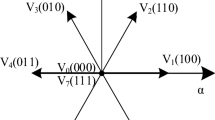Abstract
Compared with field orient control (FOC), direct torque control (DTC) is known to provide fast and robust response for induction motors. However, while offering high dynamic performance, classical DTC produces notable torque, flux, and current ripples, and operates with a variable inverter switching frequency. In this paper, a novel torque control scheme for induction motors is proposed. The stator flux and the electrical torque are directly controlled by variable-structure controllers, and stator voltage vectors calculated by the variable-structure controllers are applied to the motor by means of space vector modulation. The proposed scheme therefore provides smooth, fast and robust regulations of the electrical torque and the stator flux. Moreover, the implementation of the scheme is simple. Theoretical analysis shows the asymptotical convergence of electrical torque and stator flux tracking. Simulation and experimental results are provided to evaluate the performance of the proposed scheme.












Similar content being viewed by others
References
Depenbrock M (1988) Direct self-control of inverter-fed machine. IEEE T Power Electr 3:420–429
Takahashi I, Naguchi T (1986) A new quick-response and high efficiency control strategy of an induction motor. IEEE T Ind Appl 22:820–827
Lee KB, Song JH, Choy I, Yoo JY (2002) Torque ripple reduction in DTC of induction motor driven by three-level inverter with low switching frequency. IEEE T Power Electr 17:255–264
Martins CA, Roboam X, Meynard TA, Carvalho AS (2002) Switching frequency imposition and ripple reduction in DTC drives by using a multilevel converter. IEEE T Power Electr 17:286–297
Habetler TG, Profumo F, Pastorelli M, Tolbert LM (1992) Direct torque control of induction machines using space vector modulation. IEEE T Ind Appl 28:1045–1053
Buja G, Casadei D, Serra G (1998) Direct stator flux and torque control of an induction motor: Theoretical analysis and experimental results. In: Proc IEEE IECON’98, vol 1, 31 August–4 September 1998, Aachen, Germany, pp T50–T64
Lai YS, Chen JH (2001) A new approach to direct torque control of induction motor drives for constant inverter switching frequency and torque ripple reduction. IEEE T Energy Conver 16:220–227
Lascu C, Boldea I, Blaabjerg F (2000) A modified direct torque control for induction motor sensorless drive. IEEE T Ind Appl 36:122–130
Tang L, Zhong L, Rahman MF, Hu Y (2002) An investigation of a modified direct torque control strategy for flux and torque ripple reduction for induction machine drive system with fixed switching frequency. In: Proc IEEE IAS’02 (Industrial Applications Society) Annual Meeting, 13–18 October 2002, Pittsburgh, PA, pp 837–844
Utkin V (1993) Sliding mode control design principles and application to electrical drives. IEEE T Ind Electron 40:23–36
Romero M, Valla MI (2002) Direct torque and flux control of an induction motor with sliding mode control approach. In: Proc IEEE ISIE (Ind Symp Ind Electronics), 4–8 December 2000, Universidad De Las Americas-Puebla Cholula, Puebla, Mexico, pp 265–270
Romero M, Braslavsky JH, Valla MI (2002) A ripple minimizations strategy for direct torque and flux control of induction motors using sliding modes. In: Camacho EF, Basanez L, de la Puente JA (eds) Proc 15th IFAC Triennial World Congress, 21–26 July 2002, Barcelona, Spain
Khalil HK (1995) Nonlinear systems. Prentice Hall, Englewood Cliffs, New Jersey
Van der Broeck HW, Skudelny HC, Stanke GV (1988) Analysis and realization of a pulsewidth modulator based on voltage space vectors. IEEE T Ind Appl 24:142–150
Nik Idris NR, Mohamed Yatim AH (2002) An improved stator flux estimation in steady-state operation for direct torque control of induction machines. IEEE T Ind Appl 38:110–116
Hurst KD, Habetler TG, Griva G, Profumo F (1998) Zero-speed tacholess IM torque control: simply a matter of stator voltage integration. IEEE T Ind Appl 34:790–795
Author information
Authors and Affiliations
Corresponding author
Rights and permissions
About this article
Cite this article
Huangang, W., Wenli, X., Geng, Y. et al. Variable-structure torque control of induction motors using space vector modulation. Electr Eng 87, 93–102 (2005). https://doi.org/10.1007/s00202-003-0224-0
Received:
Accepted:
Published:
Issue Date:
DOI: https://doi.org/10.1007/s00202-003-0224-0




